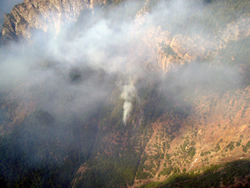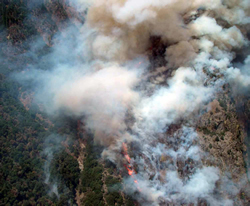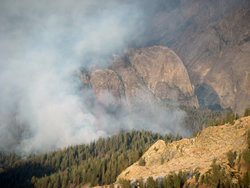
National Fire Plan Success Story
The Tehipite Fire: A Lesson in Adaptive Management
Sequoia and Kings Canyon National Parks and Sierra National Forest, California
National Fire Plan - Firefighting
2008

Steep, remote, and inaccessible terrain prevented a direct fire response for the Tehipite Fire. Tehipite Fire on July 20.

Tehipite Fire on August 14.

Tehipite Fire on September 4.
When lightning ignited the Tehipite Fire on July 14, 2008, fire managers faced a challenge. The fire was burning in some of the steepest, most remote wilderness terrain in Kings Canyon National Park, a dangerous place to put firefighters on the ground. At the same time, the state was facing some of its worst air quality in recent times. Numerous large fires in northern California, in addition to the usual pollution issues, made air quality a concern for state residents.
Sequoia and Kings Canyon National Parks had just been selected to test modifications to the federal wildland fire policy, which would allow professionals to manage fire to achieve more than one objective. The same fire may be controlled on one flank for safety, and permitted to spread elsewhere for its ecological benefit. Other factors, like cost-effectiveness, could also influence fire response.
In an effort to limit smoke production, fire managers attempted to confine the Tehipite Fire along its northern flank, where it was burning most actively. However, the treacherous terrain made this difficult. Burning material rolled down cliffs igniting fires that would burn back upslope and compromise hard-won fire lines. More critically, seven firefighters were injured in just five days on the northern flank.
Managers determined that the risk was not worth the costs to safety; firefighter and public safety are always the primary priority. Fortunately, the firefighters’ actions did slow fire growth and prevent significant spread for almost a month, helping California get through the worst period of poor air-quality.
When it became clear that the fire would grow beyond park boundaries, park fire managers began to work with the Sierra National Forest and together planned for managing the fire. A new document, the Wildland Fire Decision Support System (WFDSS), was put to use. WFDSS directs agencies to look for guidance first from existing land- management plans (wilderness plans, fire management plans, etc.). From this starting point, they can then consider a diverse array of possible objectives to manage a fire.
The park and the forest took into consideration firefighter safety, cost-effectiveness, smoke impacts, and any other values threatened by the fire such as structures, cultural resources, or sensitive habitat. Based on this, the plan they implemented involved routine monitoring with additional efforts to protect several backcountry cabins. This flexible, successful response was consistent with previous plans and land management objectives, minimized risks to firefighters, reduced taxpayer costs, and maximized ecological benefits.
The Tehipite Fire burned 11,646 acres from July 14 through the last days of October 2008. Data gathered by satellite imagery indicates the majority of the fire burned with low to moderate fire intensity. Its behavior typified fire in the Sierra Nevada, a creeping surface fire with occasional pockets of torching. For the most part, this area missed more than five natural fire cycles during the decades of unquestioned fire suppression. From an ecological point of view, the Tehipite Fire begins the process of restoring fire to an ecosystem and returning the forest to a more natural condition. Fire cleared the forest floor of accumulated dead and down vegetation and opened the forest canopy in places. The results included new growth, greater biological diversity of plants and animals in the area, and reduced chances of large, expensive, and even more difficult-to-control fires here in the near future.
Contact: Deb Schweizer, Fire Communication and Education Specialist, (559) 565-3703.